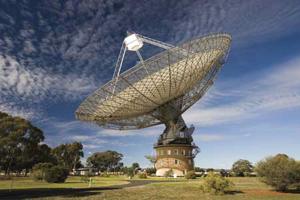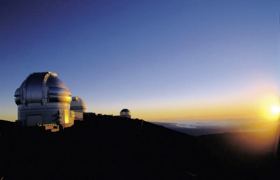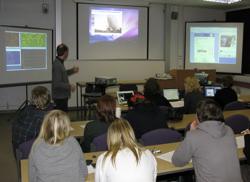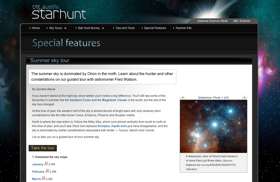|
Welcome to the first edition of the CSIRO Astronomy and Space Science Education Newsletter for 2010. In this issue you'll find:
If you have any questions about CSIRO's astronomy education and outreach activities, please don't hesitate to contact me.
Robert Hollow
Education Officer
CSIRO Astronomy and Space Science
This one-day workshop is aimed at teachers of HSC Physics and covers material in The Cosmic Engine core topic and the Astrophysics option. It is on Friday 26 March at ATNF Headquarters at Marsfield, Sydney. Sessions include background theory, current research and practical activities. Presenters from CASS and AAO include astronomers and experienced astronomy educators. Participants also receive a range of classroom resources and software. Cost is $80. For more information and to register visit the workshop page.

Come and spend three stimulating and rewarding days learning new approaches to astronomy teaching at the iconic Parkes Observatory. Astronomy from the Ground Up! is our annual teacher workshop for all science teachers on 14-16 May. It targets the content and skills of junior Science syllabi from around Australia whilst also providing depth and enrichment for teachers of senior physics. Teachers tour the radio telescope, meet professional astronomers and have lectures on different aspects of astronomy including some of the latest discoveries.

Emphasis is placed on practical and hands-on activities to take back and use in the classroom. You will also explore the wonderful dark night skies with optical telescopes. Participants receive an extensive range of resources. The workshop also fulfils the requirements of the international Galileo Teacher Training Program (external link).

This is a rare opportunity to visit some of the largest telescopes in the world including the Gemini Telescope (image below courtesy Gemini Observtaory) atop Mauna Kea on the island of Hawaii as part of a professional development tour for Australian science teachers.

This 10-day tour escorted by CASS Education Officer Robert Hollow is open to science teachers across Australia. It includes a workshop on the effective teaching of astronomy by some of the best astronomy educators in the US, a tour of the Gemini Observtaory on Mauna Kea and a viewing night from the mountain. We will visit the Hawaii Volcanoes National Park and explore other places of scientific and cultural interest to provide you with a wealth of experiences to bring back to your classrooms.
The tour departs Friday 24 September, returning Sunday 3 October. Cost is approximately $4,900. Places are limited. For more details please contact Robert Hollow.

CASS staff will be presenting talks and workshop sessions at other conferences and events in the next few months. These include the following:

The end of 2009 was an exciting time for the PULSE@Parkes project. Project Coordinator Robert Hollow was invited to give a talk about the scheme at the .Astronomy 2009 Conference (external link) in Leiden, The Netherlands in late November. The talk was streamed live over the Web allowing viewers around the world to take part and ask questions.
Following this conference Robert was joined by project member, Dr David Champion now based at the Max Planck Institute for Radio Astronomy at Bonn, to run a session in the UK. Astronomers at Cardiff University hosted our session and had arranged for students from three local schools to participate. They took control of the 64-m Parkes radio telescope on the evening of 7 December in Wales, just as it was dawn the following day at Parkes. The successful event generated strong local interest including coverage by BBC Wales.

Observing slots for April to September 2010 will soon be available for schools to apply for. The new online data analysis tool for Module One, allowing students to determine distances to pulsars, should be released next week too. Please contact Robert Hollow if you wish to know more about either of these.

On 1 December 2009 a new Division within CSIRO – CSIRO Astronomy and Space Science – was formally created.
The new Division brings together CSIRO's radio astronomy capabilities (through the Australia Telescope National Facility), NASA Operations (including the Canberra Deep Space Communication Complex), CSIRO Space Sciences and Technology and the Boeing Advisor. The enlarged business unit will encompass radio astronomy, space science coordination, advanced aerospace business development, and national/international facilities management.
For more information visit www.csiro.au/org/CASS.html.

The Big Aussie Star Hunt (external link) was developed by the ABC in collaboration with CSIRO for the International Year of Astronomy in 2009. The site has just been updated to include narrated monthly summer sky tours for January, February and March. Orion is the featured constellation.

The Big Aussie Star Hunt is also a finalist in the Australian Interactive Media Industry Association (AIMIA) Awards (external link) in the Best Science, Health or Environment category. Winners of the Awards will be announced in Melbourne on Friday 5 March 2010.

This year, high school students in Australia have a chance to use an hour of observing time on one of the world's largest optical telescopes, the 8-metre Gemini South telescope in the Andes Mountains of Chile.
How? By picking an object in the Southern sky and writing a winning explanation of why it would be interesting to digitally photograph. For contest details and to enter visit the contest website (external link). Entries close on Friday 7 May.

Your Subscription
You can update or delete your newsletter subscription details at any time by contacting robert.hollow@csiro.au
Please be assured that you will only receive CASS Education E-Newsletter and your email address won't be used for any other purpose.

|